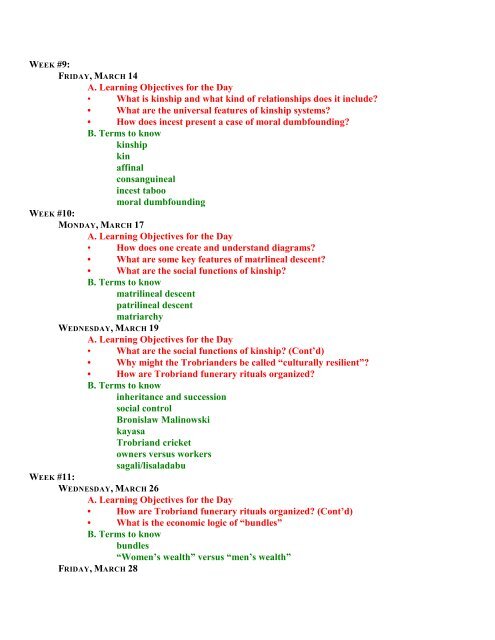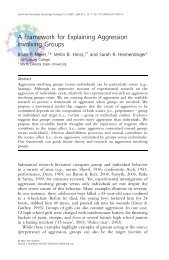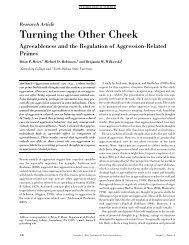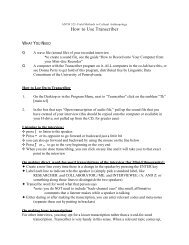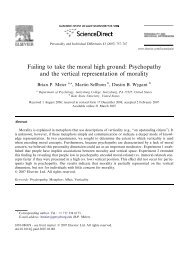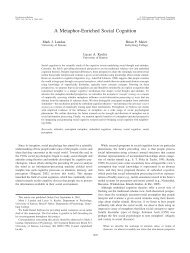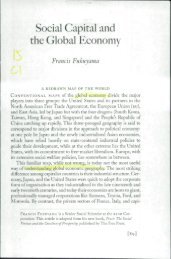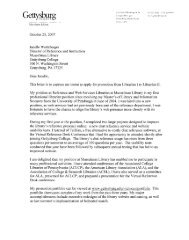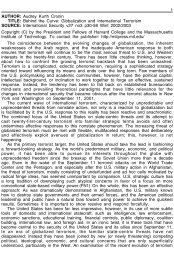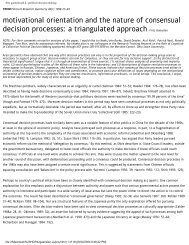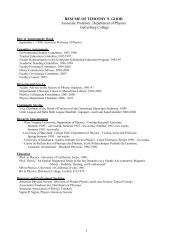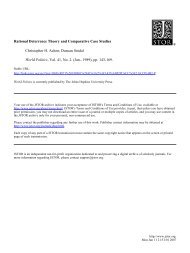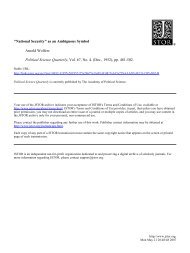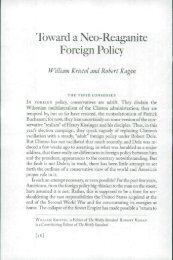A. Learning Objectives for the Day • What is kinship and what kind of ...
A. Learning Objectives for the Day • What is kinship and what kind of ...
A. Learning Objectives for the Day • What is kinship and what kind of ...
You also want an ePaper? Increase the reach of your titles
YUMPU automatically turns print PDFs into web optimized ePapers that Google loves.
WEEK #9:<br />
FRIDAY, MARCH 14<br />
A. <strong>Learning</strong> <strong>Objectives</strong> <strong>for</strong> <strong>the</strong> <strong>Day</strong><br />
<strong>•</strong> <strong>What</strong> <strong>is</strong> <strong>kinship</strong> <strong>and</strong> <strong>what</strong> <strong>kind</strong> <strong>of</strong> relationships does it include?<br />
<strong>•</strong> <strong>What</strong> are <strong>the</strong> universal features <strong>of</strong> <strong>kinship</strong> systems?<br />
<strong>•</strong> How does incest present a case <strong>of</strong> moral dumbfounding?<br />
B. Terms to know<br />
<strong>kinship</strong><br />
kin<br />
affinal<br />
consanguineal<br />
incest taboo<br />
moral dumbfounding<br />
WEEK #10:<br />
MONDAY, MARCH 17<br />
A. <strong>Learning</strong> <strong>Objectives</strong> <strong>for</strong> <strong>the</strong> <strong>Day</strong><br />
<strong>•</strong> How does one create <strong>and</strong> underst<strong>and</strong> diagrams?<br />
<strong>•</strong> <strong>What</strong> are some key features <strong>of</strong> matrlineal descent?<br />
<strong>•</strong> <strong>What</strong> are <strong>the</strong> social functions <strong>of</strong> <strong>kinship</strong>?<br />
B. Terms to know<br />
matrilineal descent<br />
patrilineal descent<br />
matriarchy<br />
WEDNESDAY, MARCH 19<br />
A. <strong>Learning</strong> <strong>Objectives</strong> <strong>for</strong> <strong>the</strong> <strong>Day</strong><br />
<strong>•</strong> <strong>What</strong> are <strong>the</strong> social functions <strong>of</strong> <strong>kinship</strong>? (Cont’d)<br />
<strong>•</strong> Why might <strong>the</strong> Trobri<strong>and</strong>ers be called “culturally resilient”?<br />
<strong>•</strong> How are Trobri<strong>and</strong> funerary rituals organized?<br />
B. Terms to know<br />
inheritance <strong>and</strong> succession<br />
social control<br />
Bron<strong>is</strong>law Malinowski<br />
kayasa<br />
Trobri<strong>and</strong> cricket<br />
owners versus workers<br />
sagali/l<strong>is</strong>aladabu<br />
WEEK #11:<br />
WEDNESDAY, MARCH 26<br />
A. <strong>Learning</strong> <strong>Objectives</strong> <strong>for</strong> <strong>the</strong> <strong>Day</strong><br />
<strong>•</strong> How are Trobri<strong>and</strong> funerary rituals organized? (Cont’d)<br />
<strong>•</strong> <strong>What</strong> <strong>is</strong> <strong>the</strong> economic logic <strong>of</strong> “bundles”<br />
B. Terms to know<br />
bundles<br />
“Women’s wealth” versus “men’s wealth”<br />
FRIDAY, MARCH 28
A. <strong>Learning</strong> <strong>Objectives</strong> <strong>for</strong> <strong>the</strong> <strong>Day</strong><br />
<strong>•</strong> <strong>What</strong> <strong>is</strong> <strong>the</strong> kula ring, <strong>and</strong> how does it demonstrate <strong>the</strong> way a male-centric<br />
ethnographic study can prevent one from underst<strong>and</strong>ing key social<br />
activities?<br />
<strong>•</strong> When <strong>is</strong> magic used by Trobri<strong>and</strong>ers? By American baseball players? How<br />
would one characterize such situations?<br />
Focus on <strong>the</strong> article, “Baseball Magic”<br />
B. Terms to know<br />
kula ring<br />
magic/sorcery<br />
WEEK #12<br />
MONDAY, MARCH 31<br />
A. <strong>Learning</strong> <strong>Objectives</strong> <strong>for</strong> <strong>the</strong> <strong>Day</strong><br />
<strong>•</strong> <strong>What</strong> are <strong>the</strong> key d<strong>is</strong>tinctions among <strong>the</strong> three major belief systems that<br />
anthropolog<strong>is</strong>ts study?<br />
<strong>•</strong> <strong>What</strong> are <strong>the</strong> minimal categories <strong>of</strong> religious behavior?<br />
<strong>•</strong> How <strong>is</strong> a shaman different than a “priest”?<br />
<strong>•</strong> How can one underst<strong>and</strong> <strong>the</strong> altered states <strong>of</strong> consciousness that shamans<br />
experience (spirit possession <strong>and</strong> trance)?<br />
B. Terms to know<br />
witchcraft<br />
religion<br />
ritual<br />
rites <strong>of</strong> passage<br />
rites <strong>of</strong> healing<br />
shaman versus priest<br />
spirit possession<br />
trance<br />
WEDNESDAY, APRIL 2<br />
A. <strong>Learning</strong> <strong>Objectives</strong> <strong>for</strong> <strong>the</strong> <strong>Day</strong><br />
<strong>•</strong> How can one underst<strong>and</strong> <strong>the</strong> altered states <strong>of</strong> consciousness that shamans<br />
experience (spirit possession <strong>and</strong> trance) <strong>and</strong> how <strong>is</strong> th<strong>is</strong> experience different<br />
from Sita’s ghost possession?<br />
d<strong>is</strong>cuss <strong>the</strong> article “Shamans”<br />
d<strong>is</strong>cuss <strong>the</strong> article “Taraka’s Ghost”<br />
<strong>•</strong> When looking at social differentiation at <strong>the</strong> local level, <strong>what</strong> are <strong>the</strong> three<br />
types <strong>of</strong> societies that anthropolog<strong>is</strong>ts recognize?<br />
B. Terms to know<br />
social differentiation<br />
egalitarian, ranked & stratified societies<br />
sumptuary rules<br />
leveling mechan<strong>is</strong>ms<br />
FRIDAY, APRIL 4<br />
A. <strong>Learning</strong> <strong>Objectives</strong> <strong>for</strong> <strong>the</strong> <strong>Day</strong><br />
<strong>•</strong> <strong>What</strong> are some character<strong>is</strong>tics <strong>of</strong> India’s caste society?
d<strong>is</strong>cuss “Castaways <strong>of</strong> Caste”<br />
see film clip “Caste at Birth”<br />
B. Terms to know<br />
Closed versus open system<br />
ascribed versus achieved status<br />
caste<br />
Brahmins<br />
untouchables (aka dalits or harijans)<br />
WEEK #13<br />
MONDAY, APRIL 7<br />
A. <strong>Learning</strong> <strong>Objectives</strong> <strong>for</strong> <strong>the</strong> <strong>Day</strong><br />
<strong>•</strong> <strong>What</strong> are <strong>the</strong> major similarities <strong>and</strong> differences between a class <strong>and</strong> caste<br />
system?<br />
<strong>•</strong> <strong>What</strong> are some <strong>of</strong> <strong>the</strong> key markers <strong>of</strong> class, <strong>and</strong> are <strong>the</strong>se markers<br />
permanent?<br />
<strong>•</strong> How <strong>is</strong> class “real,” in <strong>the</strong> sense <strong>of</strong> impacting peoples’ material well-being<br />
<strong>and</strong> life-prospects?<br />
<strong>•</strong> How <strong>is</strong> extreme global inequality evident in <strong>the</strong> world today?<br />
see <strong>the</strong> slide show “The Miniature Earth”<br />
B. Terms to know<br />
None<br />
WEDNESDAY, APRIL 9<br />
A. <strong>Learning</strong> <strong>Objectives</strong> <strong>for</strong> <strong>the</strong> <strong>Day</strong><br />
<strong>•</strong> <strong>What</strong> are roots <strong>of</strong> global inequality? (WHY <strong>is</strong> <strong>the</strong>re so much poverty in <strong>the</strong><br />
world?)<br />
d<strong>is</strong>cuss <strong>the</strong> article “Baka Beyond”<br />
d<strong>is</strong>cuss <strong>the</strong> film “Trinkets <strong>and</strong> Beads”<br />
<strong>•</strong> Is global inequality decreasing or growing?<br />
B. Terms to know<br />
paradox <strong>of</strong> <strong>the</strong> plenty<br />
colonial<strong>is</strong>m<br />
export monoculture<br />
debt cr<strong>is</strong><strong>is</strong><br />
transnational corporations<br />
FRIDAY, APRIL 11<br />
A. <strong>Learning</strong> <strong>Objectives</strong> <strong>for</strong> <strong>the</strong> <strong>Day</strong><br />
<strong>•</strong> <strong>What</strong> <strong>is</strong> social control? <strong>What</strong> <strong>is</strong> conflict resolution?<br />
<strong>•</strong> <strong>What</strong> are some strategies that non-Western societies use to en<strong>for</strong>ce social<br />
control <strong>and</strong> to resolve conflicts?<br />
d<strong>is</strong>cuss excerpts from The Forest People (“The Crime <strong>of</strong> Cephu, <strong>the</strong><br />
Bad Hunter,” <strong>and</strong> “The Giver <strong>of</strong> <strong>the</strong> Law”)<br />
d<strong>is</strong>cuss “The Kpelle Moot”<br />
B. Terms to know<br />
social control<br />
mediation versus law
WEEK #14:<br />
MONDAY, APRIL 14<br />
A. <strong>Learning</strong> <strong>Objectives</strong> <strong>for</strong> <strong>the</strong> <strong>Day</strong><br />
<strong>•</strong> How <strong>is</strong> mediation different than law? (Cont’d)<br />
<strong>•</strong> <strong>What</strong> are some character<strong>is</strong>tics <strong>of</strong> “<strong>the</strong> pure gift” (<strong>the</strong> ideal v<strong>is</strong>ion <strong>of</strong> gift<br />
exchange)?<br />
d<strong>is</strong>cuss <strong>the</strong> article “Too Many Bananas . . .”<br />
B. Terms to know<br />
gift exchange versus market exchange<br />
WEDNESDAY, APRIL 16<br />
A. <strong>Learning</strong> <strong>Objectives</strong> <strong>for</strong> <strong>the</strong> <strong>Day</strong><br />
<strong>•</strong> <strong>What</strong> are <strong>the</strong> two major systems <strong>of</strong> exchange that anthropolog<strong>is</strong>ts identify?<br />
d<strong>is</strong>cuss <strong>the</strong> article “Guarani Economics”<br />
<strong>•</strong> How does negative reciprocity in<strong>for</strong>m our underst<strong>and</strong>ing <strong>of</strong> global<br />
inequality?<br />
d<strong>is</strong>cuss <strong>the</strong> article “Guarani Economics”<br />
d<strong>is</strong>cuss <strong>the</strong> film “Trinkets <strong>and</strong> Beads”<br />
d<strong>is</strong>cuss <strong>the</strong> article “Baka Beyond”<br />
<strong>•</strong> When considering modernity <strong>and</strong> social change, <strong>what</strong> are some <strong>of</strong> <strong>the</strong><br />
dysfunctional aspects <strong>of</strong> a “culture <strong>of</strong> poverty”? Does such beliefs <strong>and</strong><br />
practices exemplify traditional, “indigenous” culture?<br />
d<strong>is</strong>cuss <strong>the</strong> article “Death without Weeping”<br />
B. Terms to know<br />
generalized (positive) reciprocity<br />
negative reciprocity<br />
culture <strong>of</strong> poverty<br />
FRIDAY, APRIL 30<br />
A. <strong>Learning</strong> <strong>Objectives</strong><br />
<strong>•</strong> <strong>What</strong> are <strong>the</strong> three ways that anthropolog<strong>is</strong>ts categorize societies experiences<br />
modernity <strong>and</strong> social change, <strong>and</strong> which way do <strong>the</strong>y tend to emphasize?<br />
<strong>•</strong> <strong>What</strong> examples can we find from th<strong>is</strong> class to illustrate <strong>the</strong>se three trajectories?<br />
B. Terms to know:<br />
ethnocide<br />
homogenization<br />
heterogeneity<br />
indigenization <strong>of</strong> modernity<br />
WEEK #15<br />
MONDAY, APRIL 21<br />
A. <strong>Learning</strong> <strong>Objectives</strong><br />
<strong>•</strong> <strong>What</strong> examples can we find from th<strong>is</strong> class to illustrate <strong>the</strong>se three<br />
trajectories? (Cont’d)<br />
See examples from <strong>the</strong> slide show “Modernity <strong>and</strong> Social Change”<br />
<strong>•</strong> How have <strong>the</strong> Hmong people undergone radical change while maintaining<br />
<strong>the</strong>ir unique identity <strong>and</strong> culture?
B. Terms to know:<br />
none<br />
WEDNESDAY, APRIL 23<br />
A. <strong>Learning</strong> <strong>Objectives</strong><br />
<strong>•</strong> How have <strong>the</strong> Hmong people undergone radical change while maintaining<br />
<strong>the</strong>ir unique identity <strong>and</strong> culture?<br />
<strong>•</strong> How does Fadiman make <strong>the</strong> familiar strange, arguing that <strong>the</strong>re are many<br />
similarities between <strong>the</strong> American relationship with <strong>the</strong>ir doctors <strong>and</strong> <strong>the</strong><br />
Hmong relationship with <strong>the</strong>ir shamans (txiv neebs)?<br />
d<strong>is</strong>cuss in small groups<br />
<strong>•</strong> How does Fadiman make <strong>the</strong> strange familiar, interpreting Hmong practices<br />
<strong>and</strong> beliefs through <strong>the</strong> lens <strong>of</strong> cultural relativ<strong>is</strong>m?<br />
d<strong>is</strong>cuss in small groups<br />
B. Terms to know:<br />
involuntary refugees<br />
FRIDAY, APRIL 25<br />
A. <strong>Learning</strong> <strong>Objectives</strong> <strong>for</strong> <strong>the</strong> <strong>Day</strong><br />
<strong>•</strong> Group-work d<strong>is</strong>cussions continued<br />
B. Terms to know<br />
culture broker<br />
role loss<br />
WEEK #16<br />
MONDAY, APRIL 28<br />
A. <strong>Learning</strong> <strong>Objectives</strong> <strong>for</strong> <strong>the</strong> <strong>Day</strong><br />
<strong>•</strong> <strong>What</strong> are <strong>the</strong> reasons <strong>for</strong> cross-cultural m<strong>is</strong>-communication <strong>and</strong> how can one<br />
deal with th<strong>is</strong> problem?<br />
compare <strong>the</strong> book The Spirit Catches You with <strong>the</strong> article<br />
“Shakespeare in <strong>the</strong> Bush” (note that <strong>the</strong> film “A World <strong>of</strong><br />
Differences” <strong>is</strong> on similar <strong>the</strong>mes)<br />
<strong>•</strong> <strong>What</strong> <strong>is</strong> <strong>the</strong> Sapir-Whorf Hypo<strong>the</strong>s<strong>is</strong>, <strong>and</strong> <strong>what</strong> does it tell us about <strong>the</strong><br />
relationship between language <strong>and</strong> culture?<br />
d<strong>is</strong>cuss “Worlds Shaped by Words”<br />
B. Terms to know<br />
mold <strong>the</strong>ory<br />
cloak <strong>the</strong>ory<br />
Sapir-Whorf hypo<strong>the</strong>s<strong>is</strong><br />
WEDNESDAY, APRIL 30<br />
A. <strong>Learning</strong> <strong>Objectives</strong> <strong>for</strong> <strong>the</strong> <strong>Day</strong><br />
<strong>•</strong> <strong>What</strong> examples from <strong>the</strong> Engl<strong>is</strong>h language show that language <strong>is</strong> always<br />
changing <strong>and</strong> <strong>is</strong> not inert?<br />
<strong>•</strong> <strong>What</strong> are some examples to support <strong>the</strong> Sapir-Whorf Hypo<strong>the</strong>s<strong>is</strong>?<br />
<strong>•</strong> <strong>What</strong> are <strong>the</strong> implications <strong>of</strong> <strong>the</strong> Sapir-Whorf Hypo<strong>the</strong>s<strong>is</strong>–in o<strong>the</strong>r words,<br />
<strong>what</strong> are some specific, highly debatable things that it claims?
B. Terms to know<br />
lingu<strong>is</strong>tic determin<strong>is</strong>m<br />
lingu<strong>is</strong>tic relativity<br />
euphem<strong>is</strong>ms<br />
language police<br />
THURSDAY, MAY 1<br />
A. <strong>Learning</strong> <strong>Objectives</strong> <strong>for</strong> <strong>the</strong> <strong>Day</strong><br />
<strong>•</strong> <strong>What</strong> does body art mean to <strong>the</strong> people who practice it?<br />
d<strong>is</strong>cuss segment <strong>of</strong> “Body Art” (film) <strong>and</strong> “Body Art as V<strong>is</strong>ual<br />
Language”<br />
B. Terms to know<br />
nonverbal communication<br />
body art<br />
FRIDAY, MAY 2<br />
A. <strong>Learning</strong> <strong>Objectives</strong> <strong>for</strong> <strong>the</strong> <strong>Day</strong><br />
<strong>•</strong> <strong>What</strong> things does an anthropolog<strong>is</strong>t pay attention to when conducting an<br />
ethnography <strong>of</strong> communication?<br />
focus on “Bedouin Blues”<br />
focus on “To Give Up on Words”<br />
<strong>•</strong> <strong>What</strong> <strong>is</strong> language death, why does it occur, <strong>and</strong> why do some people believe<br />
that we should respond with language documentation <strong>and</strong> revitalization?<br />
d<strong>is</strong>cuss “Van<strong>is</strong>hing Languages”<br />
B. Terms to know<br />
language death<br />
body art<br />
strategic essential<strong>is</strong>m


